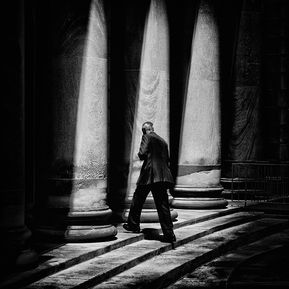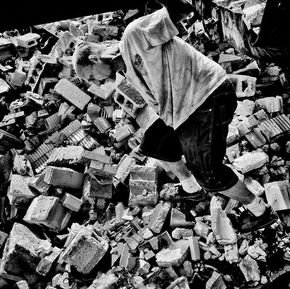FOTOTECA SIRACUSANA
PHOTOGALLERY - FOTOGRAFIA VINTAGE - BIBLIOTECA TEMATICA - CAMERA OSCURA B&W - DIDATTICA
SCRIPTPHOTOGRAPHY
Matt BLACK (USA)

MATT BLACK
Il fantasma di Tom Joad è tornato e ora estende le sue dita nere dalle grandi pianure americane fin dentro le città. Una nuova Grande Depressione si aggira e miete vittime, tante, troppe. Costoro sono le vittime sacrificali che misurano il benessere degli altri e sono esclusi dallo slogan populista del “Make America Great Again”. Sono tornati i volti polverosi della Dust Bowl che credevamo aver visto nelle immagini di Dorothea Lange e Walker Evans, solo che ora si incontrano dovunque, quasi che la povertà abbia rubato alle malattie la sua virulenza epidemica. A raccontarci un’altra America, parente poverissima dallo scintillante ottimismo demagogico di una politica sempre più rivolta a risolvere i problemi delle classi affluenti, è Matt Black. Popolarissimo su Instagram (‘Time’ nel 2014 lo ha premiato come Fotografo dell’Anno) Black utilizza in pieno le potenzialità dell’app corredando ogni foto di coordinate geografie e relative didascalie, tanto da conferire alle immagini il ruolo di un’autentica mappatura della povertà, cui basta un iPhone e una piccola Sony per essere raccontato.
“The Geography of Poverty”, titolo estremamente appropriato, è appunto una descrizione della condizione di assoluta povertà in cui è precipitata una parte consistente dei cittadini americani. Nato per descrivere la sofferenza della Central Valley (la quinta area più povera del Paese), “The Geography of Poverty”, si è esteso fino a raccontare la povertà presente negli altri stati e dunque attraverso le fotografie, corredate una didascalia comprendente il toponimo, una cifra ci informa della percentuale di abitanti che vivono nella più disastrosa indigenza. Numeri alti. E, talvolta solo apparentemente sorprendenti. E’ il caso di Philadelphia, con una percentuale di povertà superiore al 20% della popolazione; ma la forbice è destinata ad allargarsi quando si raggiungono le comunità rurali, con punte fino al 40%.
Il lavoro di Matt Black, che occorre salutare come necessario, è un reportage socio-politico di grande impatto emotivo che deve preoccuparci. Qui la povertà ha un suo volto, una sua espressione che si imprime nella galleria di uomini e donne incapaci di provvedere a cure sanitarie per la mancanza di risorse e a cui è interdetto servirsi del sistema sanitario. Si vive di indegnità, si muore di indegnità. Soprattutto ora che la nuova amministrazione americana intende cancellare la riforma sanitaria che con mille difficoltà garantiva un abbozzo di assistenza pubblica. Il fenomeno, si diceva, benché geograficamente lontano deve preoccuparci. L’America è un laboratorio del sociale e dunque ciò che accade alla sue latitudini presto o tardi giunge in Europa, ammesso che non sia già atterrato. E forse è già qui, solo che viene occultato. Le fotografie di Matt Black sono un vero documento vivente, è materia pulsante, compassionevole e soprattutto vera. La povertà qui la vediamo col suo vero volto e colpisce, nei libri di economia la povertà profuma di stampa, è una formula statistica, una percentuale fredda e distaccata. Non ne avvertiamo i morsi né il terribile destino; non vediamo la disperazione di un agricoltore braccato dalle banche e da una terra divenuta sterile come un deserto; non vediamo le lacrime solcare i volti; non immaginiamo come dev’essere mettere insieme il pasto con la cena o, più spesso dover rinunciare a entrambi. La disuguaglianze spaventano più i ricchi che i poveri ed è per questo che ne incipriano il fetore: la povertà non dev’essere vista né sentita.
Giuseppe Cicozzetti
da “The Geography of Poverty”
foto Matt Black
The ghost of Tom Joad is back and now he extends his black fingers from the great American plains into the cities. A new Great Depression hovers and reaps victims, many, too many. These are the sacrificial victims who measure the others’ wealth and are excluded from the populist slogan of "Make America Great Again".
The dusty faces of the Dust Bowl that we thought we saw in the images of Dorothea Lange and Walker Evans are back, only now they meet everywhere, as if poverty has stolen its epidemic virulence from illness. Telling us another America, a very poor relative to the scintillating demagogic optimism of a policy increasingly aimed at solving the problems of the affluent classes, is Matt Black.
Popular on Instagram ('Time' in 2014 has awarded him as a Photographer of the Year) Black uses the full potential of the app by accompanying each photo of geographic coordinates and related captions, so as to give the images the role of a real mapping of poverty, which is enough for an iPhone and a small Sony to be told.
"The Geography of Poverty", an extremely appropriate title, is precisely a description of the condition of absolute poverty in which a large part of American citizens has precipitated. Born to describe the suffering of the Central Valley (the fifth poorest area of the country), "The Geography of Poverty", it has spread to tell the poverty present in other states and therefore through the photographs, accompanied by a caption including the toponym, a figure informs us of the percentage of inhabitants living in the most disastrous poverty.
High numbers. And sometimes just seemingly surprising. This is the case in Philadelphia, with a percentage of poverty exceeding 20% of the population; but the gap is destined to widen when rural communities are reached, with peaks of up to 40%.
Matt Black's work, which should be welcomed as necessary, is a socio-political report of great emotional impact that must worry us. Here poverty has its own face, an expression that is imprinted in the gallery of men and women unable to provide health care for the lack of resources and which is forbidden to use the health system.
One lives of unworthiness, one dies of unworthiness. Especially now that the new American administration intends to cancel the health reform that with a thousand difficulties guaranteed a draft of public assistance. The phenomenon, it was said, although geographically far away must worry each one of us.
America is a social laboratory and therefore what happens in its latitudes sooner or later arrives in Europe, provided it has not already landed. And maybe it's already here, only that it's hidden. Matt Black's photographs are a true living document, a pulsating, compassionate and above all true matter.
We see poverty here it with its true face and it strikes, in the books of economics poverty smells of printing, it is a statistical formula, a cold and detached percentage. We do not feel the bites nor the terrible destiny; we do not see the desperation of a farmer hunted by the banks and a land that has become barren as a desert; we can not see tears running furiously; we don’t imagine how it should be to put together the meal with dinner or, more often, have to give up both.
Inequality frightens the rich more than the poor and that is why they stink their stench: poverty must not be seen or felt.
Giuseppe Cicozzetti
from “The Geography of Poverty”
ph. Matt Black











